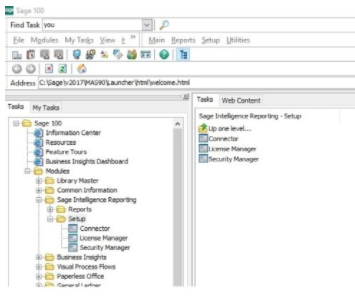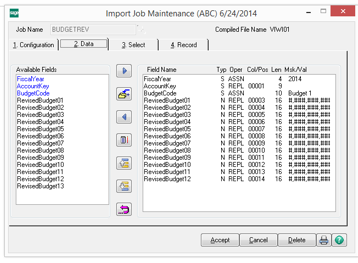Sage 100 Tips and Tricks - How to Register Sage 100 Intelligence
6 Steps to Register Sage 100 Intelligence – Sage 100 Tips and Tricks We’ve had a few questions lately about Sage 100 Intelligence and it'd be a...
4 min read
Frank Leonard Thu, Jan 08, 2015


When it comes to MRP software and ERP software, far too many stories of implementation failure litter the reputation of these projects that make investing in such change too risky for business owners. There are ERP and MRP software programs that promise big results and produce very little because they are not implemented properly. Pitfalls can be avoided (or at least moderated) by knowing what they are beforehand and not getting blindsided during the implementation process. This article examines typical reasons for implementation failures. Stay tuned for Part II and III…
When a business process or software application is successfully implemented in your organization means that it has become a routine, functioning part of your business. For example, suppose you implemented a new weekly management report in your company.1 You could reasonably say it’s a successful implementation when it is published on time every week, accurate and up to date, distributed to everyone who is supposed to get it, reviewed in a management meeting, and acted upon appropriately. In other words, the production, distribution and use of the management report has become a reliable routine in your organization. Conversely, if you have to “manage” the process to make sure the management report actually gets produced and distributed then, by definition, it’s not a successful implemented change.
It’s also important to recognize the need to “implement” the concept and value of a management report, not just the mechanics. If managers do not recognize the value of getting information on key performance indicators on a weekly basis, and/or do not act on this information to correct problems and drive continuous improvement, then the likelihood the report will fall out is high. This is an example of an unsuccessful implementation because it is not perceived as having any value or functional utility in your company.
Generally there is no single reason for implementation failures; rather, a combination of factors is involved.
In Part II and Part III of this series we will explore the following top ERP and MRP software implementation failures.
4. Solution in Search of a ProblemIf you don’t have the skills, time or talent, or if you have chosen the wrong solution, then an ERP or MRP implementation failure is likely. To increase your odds of success hire and ERP or MRP consultant for a thorough needs analysis before you choose your solution. You may consider investing in an outside implementation support consultant on a part-time or contractual basis. There are many independent ERP and MRP consultants, trainers, and project managers who can provide this service. However, be aware during your selection process that additional problems can be caused by people who know the human relations side of implementation but don’t understand the business side. The result is you can have lots of meetings, training sessions, and all sorts of organization development activities going on with only a negligible impact on company performance as a whole.
Feel free to CONTACT US at Baesis or call Len Diana at 508-393-9960 x 1011 if you have any questions about this article, Sage 100 ERP or are considering implementing a new ERP systems. We offer a free needs assessment to help you get started.
Baesis was founded with the belief that there was an opportunity to serve the SMB manufacturing community and build a company based on values and a customer first attitude. Baesis specializes in serving the SMB manufacturing community in New England, New York, Ohio, Kansas and Missouri implementing, supporting and training customers on Sage 100, JobOps, Sage 50 for Manufacturing, and MISys solutions.
Today Baesis is one of the largest Sage and JobOps resellers in the United States. Sage 100 and JobOps ERP solutions help Baesis better serve the manufacturing community in New England, New York, Ohio, Kansas, and Missouri by helping customers identify new and improved ways to increase productivity and profitability.
By Frank Leonard
References
1. "Levi’s Factory Workers are Assigned to Teams and Moral Takes a Hit. Infighting Rises, Productivity Falls as Employees Miss the Piecework System", Ralph T. King, Jr. Wall Street Journal, May 20, 1998, Page 1.
2. One of the most thorough analyses of ISO 9000 and its implications can be found in Optimizing Quality in Electronics Assembly by James Allen Smith & Frank Whitehall, McGraw-Hill, 2006, Chapter 17 pp. 430-451
3. For a revisionist view of reengineering, read Beyond Reengineering: How the Process-Centered Organization is Changing Our Work and Our Lives, Michael Hammer, Harper Business Press, 1997
Another version of this blog was posted previously on Baesis’ Tech Tips Blog on March, 01, 2014 - WHY IMPLEMENTATIONS FAIL - by Frank Leonard
Photo courtesy of www.freedigitalimages.com by Stuart Miles

6 Steps to Register Sage 100 Intelligence – Sage 100 Tips and Tricks We’ve had a few questions lately about Sage 100 Intelligence and it'd be a...

Sage 100 ERP Consultant Reviews How to Import Budgets for General Ledger Updates Automatically Question: We are a Sage 100 ERP user, how can we...

1 min read
Are you a Sage 100 ERP(formerly MAS 90 and MAS 200) customer considering options to add an online CRM application for your business? If you already...